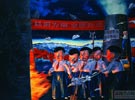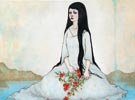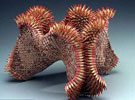To Respond to the Moment without Forgetting:
Contemporary Brush Painting by Wei Ligang
Robert C. Morgan
The practice of traditional Chinese brush painting involves much technical and formal training based in the art of calligraphy. First the artist must know the exact order and placement of each stroke within each character. Secondly, he is required to know the precise application of pressure in making each stroke. Thirdly, successful brush painting necessitates a consistency of timing to obtain an authentic rhythmic style. Finally, one must possess the skill and accuracy to properly mix water and ink. Once these skills are obtained, the further passage from calligraphy to brush painting can be a daunting and somewhat arduous affair, particularly at the beginning stages. As with any significant artistic endeavor, a strong commitment to both concept and process is essential. This includes an unwavering ability to concentrate on one's working method. Any artist who goes beyond the norm in order to take the tradition of brush painting in a new direction may not digress from the path of one's objective. The decision to progress further to a higher level of skill and intuition implies a lifetime commitment.
While reviewing a compendium of work by the Taiyuan artist Wei Ligang, I saw a reproduction of Grand Golden Curtain (2005), measuring 500 x 300 cm, and immediately grasped the power of this extraordinary painting. The "mad cursive" was there as was the inexorable precision and restraint. I was so impressed with this magnificent work of gold brushwork on a black field, given its power and restraint, its confidence and expressiveness, and wanted to see more. Soon I came upon an entirely different large scale painting, titled Great Lotus Pond in which Wei employs acrylic on paper. Here I began to realize that the distance between his work and that of the American abstract expressionist Jackson Pollock was not so far apart. I recall a photograph of Wei in his studio taken from an aerial perspective in which he semi-reclines on a large paper placed directly on the floor. His right hand is crossed over his left wrist as he is completely focused on the line he is drawing. In contrast, I recall the famous photographs of Pollock taken by Hans Namuth in the painter's studio in Easthampton from 1951 in which emphasis is given to Pollock as he stands pouring and dripping fluid paint while actively moving around the canvas. The comparison between the two artists is striking. Whereas Wei paints in relaxed stillness, Pollock is visibly emotive, moving in every direction simultaneously. It is evident that the control of Wei's brush functions differently from that of Pollock. Wei's brushwork reveals a definitive Chinese style of painting, based on ideographic signs. In his Great Lotus Pond, he perpetually deconstructs and reconstructs ideographic forms in direct relation to a cursive style of painting. Wei holds the capability to respond to the moment without forgetting or ignoring the lessons of history that empower his incredible dexterity and conceptual manner of intuition.
People's aesthetic sensibilities may radically differ when it comes to making qualitative judgments about contemporary calligraphic ink paintings, such as those produced by Wei Ligang. The "abstract" nature of these works, where the subject matter is removed from recognizable forms in the external visual world, may engender confusion or even intimidation among patrons who are otherwise interested in acquiring works deemed significant. In a recent essay published in 2009, I advocated the importance of restoring a sense of criterion and connoisseurship to the manner in which we judge such works. China has one of the oldest traditions whereby highly trained connoisseurs were sought out in order to make accurate assessments of quality pertaining to works of art -- a tradition that goes back to the courtly paintings of the Han Dynasty and was later perfected during the Tang Dynasty.
From this early traditional perspective, connoisseurship was concerned with two indispensable aspects of art: One was to determine the authenticity of the object or painting, particularly in relation to its historical placement; and the other was to apply a qualitative standard in order to assess the work's originality or mediocrity, as the case might be. Of course, the range between these antipodes was huge given the minute degrees of subtlety that resided between them. Such an analysis would necessarily involve the concept, material, technique, structure, and emotional content that would lead to an aesthetic understanding of the work and a clear appraisal of its worth. This concept of a criterion in art lasted through the ensuing dynasties, but varied according to its emphasis, especially as the literati rose to prominence in the 11th and 12th century and eventually found acceptance among benefactors. By the end of the Qing Dynasty, the institutional practice of connoisseurship had run its course through excessive political in-fighting and academic squabbles much to the detriment of offering anything of significance to the pedagogy of aesthetics. By the second half of the previous century, it was apparent that the origins of this kind of elitist expertise had either degenerated or was temporarily hidden from view, given the rise of the Republic and the uncertain years of the revisionist regime that followed.
Wei Ligang is in the process of opening the threshold to a new form of calligraphic painting that has come to the forefront of critical attention as his audience in China has become capable of grasping it. Given the revival of interest in contemporary forms of Chinese ink painting in recent years, it would appear appropriate to develop a fresh approach to connoisseurship as seen through the window of conceptual art. However, a return to tradition for the sake of tradition in the form of a regressive connoisseurship would appear not out of context but most likely be at odds with the contemporary art market that emerged at the outset of the current century. It is time for a new approach to a critical and qualitative thinking to occur within the practice of calligraphic ink painting today, and it is for this reason that Wei Ligang's inventive and incisive paintings will continue to play a central role.
Recent scholars have traced the history of the resurgent interest in abstract or "metaphysical" ink painting going back four hundred years to the Ming Dynasty, specifically to the time of Fu Shan, the calligrapher from Shanxi Province who combined a cursive style of writing with obscure greater seal scripts going back 2000 years. Wei Ligang regards the calligraphic inventiveness of Fu Shan as a mentor in that they were both from the same region of China and were similarly attuned to the inherent values available in the act of using calligraphy as a structural basis in painting. Given Wei's personal interest in mathematics and calligraphy, he saw an opportunity to move his project ahead using a conceptual system called "Magic Squares." Realizing that Chinese ideographs are essentially dependent on a grid system or matrix of variations within a square, Wei Ligang proceeds to experiment with this idea and to transform it into a viable concept through his supreme gift for manual writing. Bright Palace Fu (2010) – obviously an homage to his 17th century mentor Fu Shan -- is a good example. Painted in acrylic paint on Xuan paper, there is a grid in which the ancient seal scripts are torn apart and rebuilt without disrupting the essential format indigenous to their origins. This recalls a previous work, titled Wilderness Grotto, also based on the "Magic Square" from a previous exhibition, where the cursive script invigorates the order of the ancient seal script. In addition to Wei's brilliant maneuvers with the Magic Squares, one must pay attention to the sheer beauty of the artist's recent acrylic paintings on Xuan paper (all from 2010), including such works as Buddha Fingers, Ascending, Wooden Horse, Loch Ness #3, and Holy Hill. In each case, the genius of specificity in the artist's ability to conjure an image that goes deeply within the mystic sources of his tradition emerges as a universal sign. To grasp the instantaneous beauty of this work is to open a new threshold to the possibility of an indigenous style of Chinese painting that holds a transformative power in its ability to transmit important intellectual and emotional values.
Robert C. Morgan is an international critic, curator, lecturer, and artist, who lives in New York City. He holds an advanced degree in Sculpture (MFA), and a Ph.D. in contemporary art history. He is Professor Emeritus in Art History at the Rochester Institute of Technology and Adjunct Professor of Fine Art at Pratt Institute in Brooklyn, New York. As a winner of many awards, he has authored numerous books, essays, catalogs, monographs, and reviews, many of which deal with Korean and Chinese artists.




